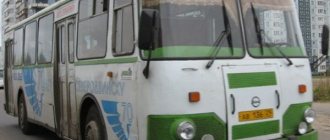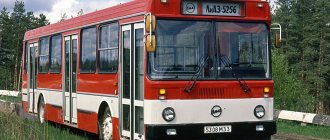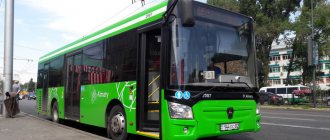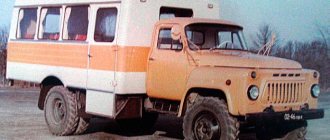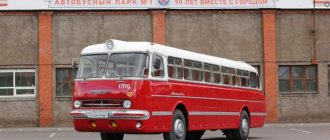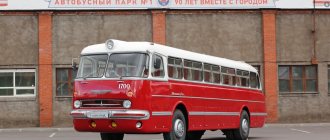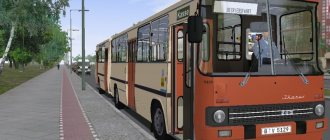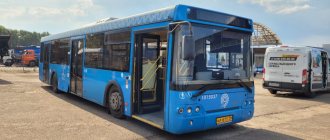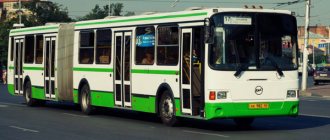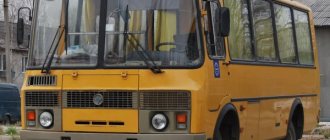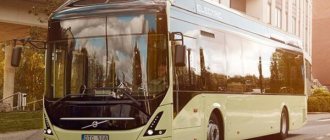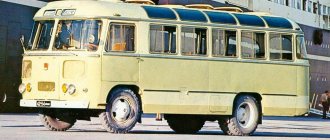Author: zaMKADpride
June 14, 2016 08:11
Tags: LiAZ 677 LiAZ buses
12169
22
This bus has become one of the symbols of public transport of the former USSR - few people are not familiar with this big, pop-eyed beast. Now many people also know about its technical features, such as automatic transmission, and those who are especially advanced even know what made the famous “clanging of empty bottles” when moving. Well, now it’s time to talk about how it was born and what modifications of this machine worked for the benefit of man.
0
Source:
See all photos in the gallery
In the photo: ZIL-158
0
Source:
In 1958, production of ZIL-158 buses was transferred from the Likhachev plant in Moscow to the Likinsky Machine-Building Plant, which in those years produced components for Moscow trucks. Since that time, the plant in Likino-Dulevo was renamed LiAZ. The first buses left the production gates in January 1959, and during production until 1970, over 62,000 copies were manufactured. The outdated design was also criticized by drivers who sat next to the engine and constantly breathed gasoline vapors, and in the summer they were also fried by the heat from the engine. Another legend was the unsynchronized manual transmission with a complex activation mechanism, which is why the driver of the “158” was very tired by the end of the shift. Well, passengers did not like the narrow wing doors, which greatly worsened the rotation during rush hour.
×
Basic information, characteristics
Manufacturer/manufacturer where the equipment is produced/manufactured. Likinsky Bus Plant (LiAZ) is a Soviet and Russian enterprise, a manufacturer of medium, large and extra large class buses, located in Likino-Dulyovo, Moscow region.
Purpose. Urban.
Class. Big.
Body type. Semi-supporting, carriage type.
In the photo: ZIL-158V
0
Source:
In 1960, LiAZ designers, with the support of NAMI, built an experimental bus ZIL-E158D, equipped with a hydromechanical gearbox developed by a Moscow institute and a new suspension on air springs. A number of elements tested on the experimental design subsequently formed the basis of the modernized ZIL-158V bus, which received a new synchronized gearbox, a stronger clutch and an improved parking brake system. Buses of the ZIL-158 model were produced until 1970, and for several years the 158 shared the conveyor line with the new model. Work continued in the area of improving passenger boarding on the bus.
LiAZ-677
0
Source:
Analyzing the experience of building experimental buses, NAMI and LiAZ almost immediately realized that a modern bus could be built only by abandoning the outdated ZIL-158V body. The development of a new generation bus began in 1960, and the first prototype was released on November 6, 1962 - on the Anniversary of the Revolution. In the factory documentation, the new generation high-capacity city bus received the index LiAZ-677.
0
Source:
In addition to the new wagon-type body, developed completely from scratch, the new product received a powerful 180-horsepower ZIL-375YA7 gasoline engine, borrowed from the Ural-375 truck, which, unlike its army version, was derated for A-76 gasoline and received new heads blocks and another carburetor. It was thanks to this engine that the LiAZ-677 bus became notorious for its fuel consumption, which could reach 50 liters per 100 km. The consumption was also aggravated by the new two-stage hydromechanical automatic transmission LAZ-NAMI-Lvov 22.17, which, due to the poor build quality of the torque converter, was prone to oil loss and overheating. The box was controlled by a key block on the front panel. To improve the smoothness of the ride, a dependent suspension of all wheels on air springs was used, and to increase the driver’s comfort, they tried to isolate the engine next to it as much as possible. To increase passenger capacity, the LiAZ used a three-row interior layout and a rear storage area with a lowered floor level and a ramp, and better rotation of passengers at stops was ensured by two pneumatic doors of increased width. In total, the bus could accommodate up to 110 passengers, 25 of whom were seated.
0
Source:
A year later, the experimental bus was presented to the State Commission for Automation and Mechanization, which, after examining the bus, gave it a positive assessment. Traction, technical, running and climatic tests of the prototype were carried out in 1965, for which several vehicles were sent on a test run Moscow-Kharkov-Novorossiysk-Sochi-Tbilisi-Erevan-Ordzhonikidze-Moscow. In 1966, three more experimental buses were built, and the entire first batch of five vehicles was transferred for trial operation to Moscow automobile plants, where they received generally positive reviews from the operators. Everyone understood that the machines presented for accountable use were still “raw” and had “childhood diseases.” The plant resolved problems as quickly as possible. Due to increased deformation and subsequent destruction of the main load-bearing elements, the body frame was almost completely redesigned, which made it possible to improve the rigidity of the bus, and the suspension kinematics and mounting points for the levers were completely revised. The material of the air spring shell has also changed, the first of which tended to burst under heavy loads.
0
Source:
Serial production of a pilot batch of buses built using bypass technologies began in 1967, and already in 1968, in order to reduce the weight of the bus and increase its corrosion resistance, some of the external elements of the body skin were made of duralumin sheets, which were attached to the frame with riveting. A number of sidewall elements were made from them (on the left - a sheet under the driver's door and separate sheets to the stern, on the right - sheets between the passenger doors and on the side of the cabin) and the central part of the rear panel, and several more sheets of duralumin were located on the roof. Despite all the advantages of duralumin, by 1982, after modernization, they decided to get rid of the expensive material: even in PATP, during repairs, in most cases steel sheets were installed on buses. Another factor was savings and improved manufacturability of production: riveting of sheets was done manually, and with the production of 10,000 buses per year, the labor costs of the employee turned out to be enormous. LiAZ-677 moved to the main conveyor, two years later completely displacing the veteran LiAZ-158V. For the creation of the bus, the team of plant workers was awarded VDNKh medals, where one of the prototypes was exhibited in the Mechanical Engineering pavilion. In 1972, the new Soviet bus was shown at the International Fair in Leipzig, where it received a 1st degree diploma and the Great Gold Medal of the exhibition.
0
Source:
By the way, since 1973, buses of the brand have been exported. Mostly LiAZ-677E went to the Warsaw Pact countries, but a certain number of vehicles also ended up in Cuba. They also worked in the GDR. For the needs of urban transport, from 1973 to 1979, 370 LiAZ-677 buses were purchased, which subsequently operated in small regional centers. In order for the bus to pass certification on the German market and meet all requirements and standards, the lighting equipment had to be completely changed. At the front, rectangular headlights appeared, which were installed on the Moskvich-412, and the place of the standard round taillights was taken by new square ones.
In 1976, the Likinsky Bus Plant was awarded the Order of the Red Banner of Labor for organizing the production of new bus models and early implementation of the five-year plan. Of course, almost every year some changes were made to the bus. So, in 1977, new speakers appeared in the cabin, an increased power generator with a built-in relay-rectifier, and already in 1978, an anti-icing system for pneumatic system hoses appeared, emergency shutdown of the “mass” with buttons in the cabin and on the body, as well as a sliding window in the right window driver's cabin.
Design
The basis of the bus is a semi-supporting carriage-type body with a reinforced base. The bus has three doors - two for the passenger compartment, one for the driver. The power plant is a ZIL-509.10-401 gasoline engine, 8-cylinder, V-shaped, with a displacement of 7.0 liters and a power of 175 hp. With. (129 kW). The cylinder operating order is 1-5-4-2-6-3-7-8, compression ratio is 7.3. Torque – 48 kgf*m (470 N*m) at 1800-2000 rpm. The engine is equipped with a K-90B carburetor and an inertial oil filter.
The hydromechanical transmission has a two-speed automatic gearbox. The rear axle is Hungarian RAVA-MAN. Dual-circuit braking system with pneumatic drive.
Electrical equipment - on-board network 12V, 2 batteries 6ST-90, generator G287-L has a built-in voltage regulator YA112-A, distributor P137, starter ST130-A1, ignition coil B114-B, transistor switch TK102-A, spark plugs A11.
The wheels are discless, 3-piece 8.0-20 rims mounted on six studs. Tires 280R508 (10.00R207) with road tread pattern. The pressure in the front tires is 7.5 kgf/cm2, in the rear tires – 6.7 kgf/cm2.
The dependent suspension consists of: at the front – semi-elliptical springs, two shock absorbers, two air springs, at the rear – semi-elliptical springs, four shock absorbers, four air springs.
Steering - Ural-377N models, the steering mechanism consists of a two-way worm and a sector, hydraulic booster. The nominal pressure in the amplifier is 65 kgf/cm2. Gear ratio – 21.5. When the amplifier is running, the steering wheel play does not exceed 12 degrees. The ZIL-375 engine is also installed on Ural-375 military trucks. This is the ZIL-130 engine, which has been boosted by switching to AI-93 gasoline and increasing the working volume.
Later, especially for buses, this engine was derated by switching to low-octane gasoline A-76. This engine gained notoriety due to its high fuel consumption - it could reach 50 liters per 100 km, which was aggravated by losses associated with the automatic transmission.
LiAZ-677M
0
Source:
LiAZ engineers started thinking about serious modernization of the bus back in the mid-1970s. In 1975, a pilot batch of 35 buses was built, which featured a different front design with a plastic grille, and the door leaves were made of aluminum alloy. Inside, the main change was a new truss frame with increased rigidity. In the photo: LiAZ 677M pre-production
0
Source:
0
Source:
Changes also affected the transmission. The hydraulic transmission has been significantly strengthened, and the installation of a rubber coupling has reduced vibration levels and increased the service life of universal joints. New components appeared in the braking system, which allowed it to meet modern safety requirements. Buses began to be equipped with sunroofs, initially typical only for suburban modifications, “entry/exit” windows above the doors disappeared, replaced by a blank steel panel, some side windows were turned into emergency ones and were deprived of vents, and the old rear axle of the Hungarian company Raba was replaced with a modern one of the same brand, with different gear ratios, reinforced gearbox and axle shafts. To improve the driver's working conditions, new sealing materials were used, which made it possible to minimize gas pollution and noise in the cabin. The entire pilot batch went into operation at the Moscow automobile plants. It is known that several “Emoks” worked for many years in the first, second and fifth bus depots of the capital. However, the new front mask was considered unprofitable to produce, so the serial LiAZ-677M, put into production in 1982, differed from the “regular 677s” by an additional grille for cooling the engine at the front and a single ocher-yellow paint scheme, for many years years, which became the main one for the model.
0
Source:
Since 1984, new front and rear bumpers began to be installed on the bus, and new lighting equipment appeared that meets international requirements. At the rear, square lights appeared, consisting of four headlights: side lights, brake lights, reversing lamps and turn indicators, and at the front, in 1986, the front upper lights were replaced with rectangular ones. Changes also affected the interior. The driver got a new seat with its own suspension, adjustable in height, length, backrest and cushion tilt, the ventilation system and interior trim were changed: some of the elements were made of low-flammability plywood, and the seats were reupholstered with leatherette.
Driver's workplace
The engineers sought to conduct the project in such a way that the driver would be very comfortable and functional. What can you say about the LiAZ 677 cabin? Its characteristics are information content and ergonomics. But at the same time there is nothing superfluous there. The instrument panel had a characteristic design for those years.
The driver's seat was sprung and made it possible to adjust the height, angle of the backrest or cushion. The cabin and engine compartment were fenced off with a wall. In some modifications, a window was installed, like on the Ikarus. This window had a window for passengers.
LiAZ-677B
The main modification of the bus that entered the assembly line in Likino in 1973 was the suburban LiAZ-677B. The bus differed from its “urban” counterparts in its four-row interior layout and the same floor level in the cabin. Sometimes it is mentioned that the main difference between the 677B externally and the urban version is the bracket for mounting the spare wheel at the rear of the body. Actually this is not true. The bracket was part of the standard equipment of any production bus. The fact is that in the event of hostilities, the LiAZ-677 was planned to be used as ambulance buses, the standard seats in which could easily be replaced with the included stretchers. Of course, the spare wheel in the interior, prepared for medical work, turned out to be superfluous and, according to the doctors’ requirements, was moved outside. In peacetime, the spare wheel and bracket, respectively, were stored on the territory of the ATP, and according to the rules, to replace the wheel it was necessary to call a technician from the park. In the photo: LiAZ-677B
0
0
0
0
The welded frame for all buses was the same; an additional section of the high floor was welded onto the standard frame. LiAZ engineers thought out a design that was maximally unified with the body of the existing urban version, without major changes to the production line, which, of course, would reduce the number of buses produced, while the country needed an increasing number of them every year. The rear truss contains guides for joining the floor frame for suburban modification. Two more guides are hidden in the area of the rear arches. To create a section of a flat floor, a frame was developed, welded from square pipes. To secure it to the power side members and body trusses, additional docking points were introduced, which were not dismantled if the bus was an urban modification. To accommodate the spare wheel under the floor, a hatch was constructed in the rear of the body, secured with two separate locks. For maximum unification in production, it was brought into line with the battery compartment hatch. For the same purpose, front door leaves were installed on suburban modifications, because the floor height in this case was identical to the front part. In total, the commuter version could accommodate up to 87 passengers, of which 35 were seated. Modification 677B was produced from 1973 to 1978; subsequently, its place on the assembly line was taken by the modernized version LiAZ-677MB, which had a similar design.
LiAZ-677A
0
Source:
Especially for areas with a cold climate (from – 60 °C), the northern modification 677A was developed (after the modernization of the LiAZ-677MS), which differed from its analogues in double glazing, thermal insulation and a four-row interior layout. Buses were produced to order in small batches. To solve problems with increased fuel consumption, bus modifications were developed that ran on liquefied gas and were produced in small batches. The LiAZ-677G differed from its gasoline counterparts in a box with three gas cylinders on the roof, as well as reduced engine power due to the conversion to gas and, as a result, lower passenger capacity.
LiAZ-677P
0
Source:
Based on the LiAZ-677, there were other interesting modifications, for example, a sightseeing bus with one door, a four-row interior layout and a seat for a guide, as well as an improved interior ventilation system and separate lighting shades, which never went into production so as not to create competition. Lviv buses. Another interesting modification was the LiAZ-677P apron bus, built in 1974 in the number of three prototypes. Unlike its counterparts, it had two doors to the cabin on each side of the body and only ten passenger seats. Additional doors and a low number of seats make it easier for passengers with luggage to get on and off the bus, and the travel time is no more than five minutes from the airliner's ramp to the airport apron. However, the bus was not widely used. The main reason for the refusal was the high floor, which made it difficult for passengers to board and disembark, as well as the small capacity by aviation standards. The LiAZ-677P could serve the Tu-134 or Tu-154, but for the more capacious airbuses Il-62 and Il-86 it was necessary to use two buses.
LiAZ-677P quickly found a replacement in the form of the APPA-4 road train, which was a passenger semi-trailer with a low (350 mm) floor level and a ZIL-130 tractor. The first LiAZ-677 often had problems with the automatic transmission, the professional repair of which was mastered by the mechanics of city enterprises. As a rule, airport automobile enterprises did not have specialists in automatic transmissions, which is why the transmission was repaired in specialized technical centers, which also prolonged equipment downtime. In the case of APPA-4, there were no such problems - the repair of service ZIL-130s was well mastered, and in the event of a breakdown, the tractor was easily replaced with another.
Transmission
The engine was paired with an automatic transmission. Here it should be said right away that this is the first bus with a checkpoint of this type.
Many drivers were immediately able to appreciate all the benefits that automation provided them. A two-speed gearbox made it possible to reach a maximum speed of 70 km/h.
Naturally, this box was significantly different from modern models, but it was quite reliable and simple. It could be repaired very quickly.
LiAZ-5930 PTS-4/LiAZ-5931 Lotus/LiAZ-5932 Magnolia
0
Source:
Separately, it is worth talking about mobile television stations built on the basis of the LiAZ-677 bus. In 1964, in connection with the commissioning of the television center under construction in Ostankino and the introduction of new generation television equipment, work began on the development of a mobile television station on the chassis of the new LiAZ-677 bus. In 1972, the first two specialized buses under the name PTS-4 were produced at the television plant in Siauliai. The station was intended to record television broadcasts from cultural events taking place on the street: concerts, rallies, parades. The chassis of the LiAZ-677 bus was equipped with a new all-metal welded van-type body, the walls and roof of which had additional thermal insulation. The roof of the bus was used as a platform for camera operators to operate. The reinforced steel panel could support up to three people and television equipment. To lift operators, a ladder was provided at the rear of the body, and to lift the necessary equipment, a winch with a lifting capacity of 60 kg was used. To ensure that the bus stood stably on the surface during operation, the driver extended outrigger support devices. Inside the bus there were consoles for the director, video engineer and sound engineer, six folding and five swivel seats, hangers with clothes, a table, a telephone and two wardrobes. To increase the comfort of working inside the bus, a forced ventilation system was developed that uses heat from the engine radiator for heating in winter, and in summer the cabin was cooled by two KT-4 air conditioners, powered in parking lots from an external network. The luggage compartments contain transformers, cable winding mechanisms and a shield for audio cables. The special bus LiAZ-5931, which received its own name “Lotos”, differed from the early model 5930 only inside: the Lotus had equipment for recording color pictures for television. The cars were produced in small batches at the Siauliai plant until 1974, where they were subsequently replaced by a new television station, designated LiAZ-5932 Magnolia. It differed from its predecessors in its improved television equipment, thanks to which it could immediately transmit live broadcasts. The Magnolia plant produced small batches until 1982.
0
Source:
Separately, it is worth noting that to service the PTS, an auxiliary bus was used, which accompanied the station during operation and was a converted LiAZ-677 for transporting television cameras, tripods, cables and other necessary equipment. In addition, the bus was used as a utility room for station staff, and only the front three-seater sofas were usually left in the passenger compartment.
Body and interior
What was the LiAZ 677 - a model that is a symbol of happy days for many?
The carriage-type body had a supporting structure. Sections and parts of the body were connected to each other using rivets hidden under overlays, which served a decorative function.
The interior was lined with laminated plastic. There was a sign above the windshield, where on one side they put the number of the route on which the car was operating, and on the other side - information about the route.
Lighting was provided by six ceiling lamps with fluorescent lamps.
Folding vents in each window allowed the interior to be naturally ventilated.
The heating system deserves a special mention. It represented an outflow of hot air, which was obtained from engine cooling. The air duct ran along the left side of the body, and on the left side in the front, right behind the driver's partition, on a frosty day people even fell asleep in the body.
